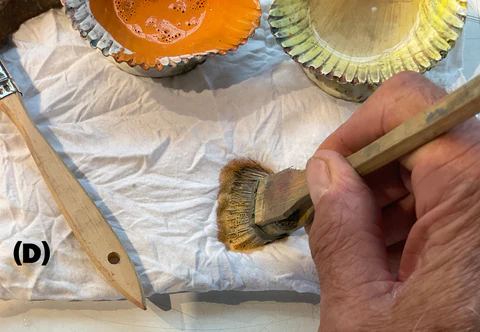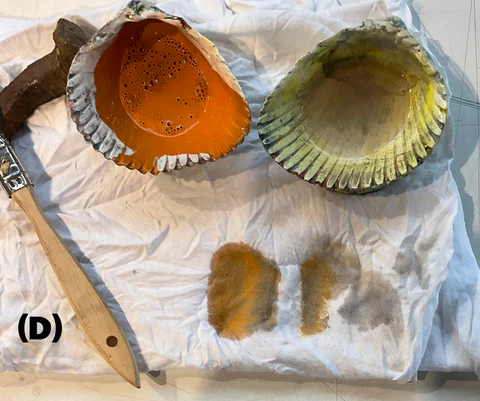Someone asked about the details of inking a woodblock using the moku hanga process. For me, one of the attractions of the process is the hands-on-touch throughout the entire process and especially the inking. When inking, I am always striving for the perfect balance of moisture between the paper, block and brush, ink being a part of the brush.

The most common mistake I see beginning printers make is using too much ink which creates a muddy print with indistinct linework or shapes. When too much ink is applied to the block, that excess ink will puddle in the low areas and at the edges of the relief carves. No matter how careful one is about printing, that excess ink will be picked up by the moist paper. The drawing above illustrates how too much ink puddles into the low areas of the block. The bottom drawing has a thin even layer of ink over the block.


This group of photos illustrates the application of the ink. The (A) photo shows too much ink applied to the block and the detail shows the ink filling the space between the carved lines. The (B) photo shows a smaller amount of ink applied to the block and the detail shows how little ink is on the block.

Photo (C) illustrates the two inkings printed. The over-inked printing on the right shows how the ink has filled in between the carved line work while the lightly inked block on the left shows crisp linework without the gaps between the carved lines filling in.

During printing, I am always watching the amount of ink between the brush and the block. If the ink begins to bubble when being brushed out, then there is too much moisture. When I see this, I blot the brush on a rag, pulling out as much moisture as I can. I keep the rag easily accessible so I can blot the brush anytime I feel excess moisture is building up on the block or in the brush. In the photo (D), the left blot is from too much moisture in the brush. The right blot is much lighter, indicating there was less moisture in the brush.

All these variables may seem overwhelming and give one second thoughts about printing with the moku hanga process, yet, when mastered, these variables are what make moku hanga printing so exciting and rewarding. There are so many different ways to ink the woodblocks and the key to all is the amount of ink used. I am always surprised as to how little ink is needed to print a nice color.
Enjoy the process.
